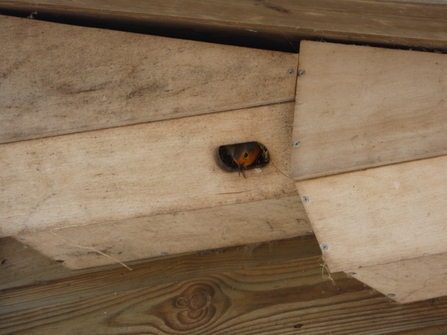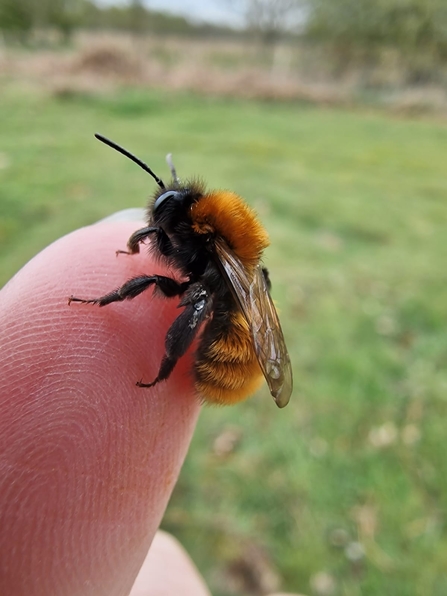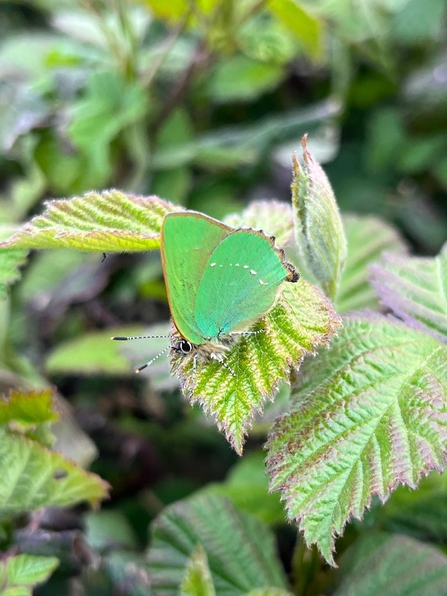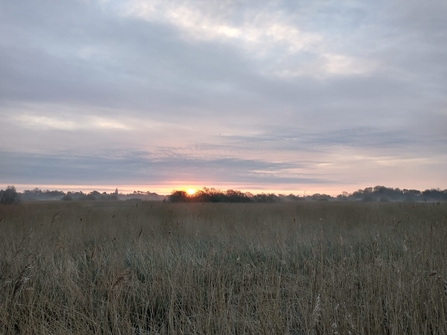Wild news from our reserves – 28 April 2023
Field forget-me-not from Lackford – Joe Bell-Tye
Andy Hickinbotham, our warden for Lound Lakes, was alerted to some very unusual and special visitors to the reserve on Monday this week. A dog walker spotted two strange-looking herons perched in trees beside the lake, and they turned out to be adult, black-crowned night herons.
As it was safe to view them without disturbance, Andy alerted a local birdwatching group, and a gentle stream of thrilled bird watchers made their way to the reserve to view the spectacle. Andy kindly kept the car park open beyond its normal closing time to facilitate the birdwatchers, which was highly appreciated. The birds moved on from Lound that evening, flying in a south-easterly direction.
Andy discovered there were a total of five black-crowned night herons reported in the UK and Ireland on Monday, these were in Clyde, Cork, and Lound Lakes in Suffolk.
There has been a recent influx of these birds, but all have been on the western side of the UK, which is why they created a stir in Suffolk. A possible cause for the influx has been put down to the drought conditions in continental Europe, causing birds to move north to feed. They can usually be seen around the Mediterranean, with closer colonies in the Netherlands and Germany.
Thank you to Andrew Easton for sharing these lovely images of the herons.
Buff-tailed bumblebee
Visitor Officer Hawk Honey got this great slo-mo footage of a buff-tailed bumblebee leaving its nest at Lackford Lakes.
A refuge for reptiles
Reptile tins are being added and relocated at Lound Lakes. These refuges are placed on the ground in sunny spots located by water. They absorb the warmth and offer cover from predators and will be used as a refuge by lizards and grass snakes. Volunteer Rob Quadling found six slow worms under one tin whilst surveying this week!
Imposter
The Lackford Lakes team discovered an imposter on site. They have a robin nesting in one of our swift boxes at Lackford Lakes. This little face is definitely a robin and not a swift!

Robin nesting in swift box at Lackford Lakes - Michael Andrews
Sedge warbler
This gorgeous sedge warbler was filmed by Justin Zantboer at Trimley Marshes this week. It was a male who was first ringed at Trimley in 2018, making it six years old this summer!
Windpump wets the landscape
The windpump installed last year has helped transform this marsh at Oulton with displaying lapwing and redshank now present where before there were none.
Vernal mining bee garden
Hawk Honey spotted this lovely meandering garden path created by a vernal mining bee (Colletes cunicularius) at Lackford Lakes.

Vernal mining bee (Colletes cunicularius) nest entrance – Hawk Honey
Tawny mining bee
Reserve Intern Anneke Emery got up close with this tawny mining bee at Knettishall Heath this week – we love that ginger fuzz!

Tawny mining bee – Anneke Emery
Green hairstreak
Warden Joe Underwood spotted this beautiful iridescent green hairstreak butterfly on bramble at Trimley Marshes. Green hairstreaks are found in dry, scrubby habitats; the caterpillars feed on various plants, including bilberry, bird's-foot trefoil, broom, dogwood, bramble and gorse. on bramble. Thanks to Justin Zantboer for this great photo.

Green hairstreak - Justin Zantboer
Dawn chorus
Warden Lewis witnessed an amazing dawn chorus at Carlton Marshes this week, with cuckoo, bittern, water rail, sedge, Cetti’s and grasshopper warbler calls amongst others. The sunrise was equally stunning.

Sunrise at Carlton Marshes – Lewis Yates
Spring flowers at Lackford
Warden Joe Bell-Tye spotted some more wonderful wildflowers at Lackford Lakes.
First lapwing chicks at Carlton Marshes
Warden Gavin Durrant was thrilled to spot this lapwing taking a dip, and active redshanks on Peto’s Marsh scrape this week. Volunteer Andrew Easton also spotted this season's first lapwing chicks on the Turnpike scrape, which will hopefully the first of many.
Ponies grazing the Hen
Four ponies were moved from their wintering grounds at Carlton to Hen Reedbeds today. They were excited to arrive and are settling into their conservation grazing role very well already.
Belties get stuck in at Framlingham Mere
Our Belted Galloway cattle were equally happy to be grazing at Framlingham Mere. Thanks to Grazing Manager, Jane Barber for this clip.
Bridge repairs
Wardens Lewis Yates and Frances Lear repaired the bridge at Gunton Meadow this week. It is now much easier and safer to get across.














